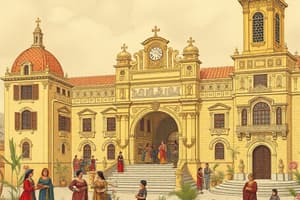Podcast
Questions and Answers
Which characteristic of culture emphasizes that it is not inherited but learned through social interaction?
Which characteristic of culture emphasizes that it is not inherited but learned through social interaction?
- Shared
- Learned (correct)
- Symbolic
- Dynamic
What aspect of culture allows individuals to connect through common values, beliefs, and practices?
What aspect of culture allows individuals to connect through common values, beliefs, and practices?
- Prescriptive
- Shared (correct)
- Dynamic
- Integrated
Which of the following is an example of non-material culture?
Which of the following is an example of non-material culture?
- Religious faith (correct)
- A piece of art
- A national flag
- A smartphone
How does culture demonstrate its dynamic nature?
How does culture demonstrate its dynamic nature?
What do cultural norms primarily provide within a society?
What do cultural norms primarily provide within a society?
Which element of culture refers to the objects and gestures that represent ideas?
Which element of culture refers to the objects and gestures that represent ideas?
Which of the following best describes how material culture can influence non-material culture?
Which of the following best describes how material culture can influence non-material culture?
What is the significance of language in culture?
What is the significance of language in culture?
What is the primary function of norms within a culture?
What is the primary function of norms within a culture?
Which aspect reflects the material culture of a society?
Which aspect reflects the material culture of a society?
Which of the following best describes customs and traditions?
Which of the following best describes customs and traditions?
How do values influence social cohesion in a culture?
How do values influence social cohesion in a culture?
What role does informal education play in cultural transmission?
What role does informal education play in cultural transmission?
In what way does language act as a vehicle for cultural identity?
In what way does language act as a vehicle for cultural identity?
What distinguishes transformational leadership from other leadership styles?
What distinguishes transformational leadership from other leadership styles?
What challenge does globalization pose to cultural identity?
What challenge does globalization pose to cultural identity?
How does modern technology contribute to cultural adaptation?
How does modern technology contribute to cultural adaptation?
Which aspect does not fall under structural quality in educational leadership?
Which aspect does not fall under structural quality in educational leadership?
In democratic leadership, the primary focus is on:
In democratic leadership, the primary focus is on:
Which leadership style would likely hinder collaborative decision-making?
Which leadership style would likely hinder collaborative decision-making?
What role does mentoring play in educational leadership?
What role does mentoring play in educational leadership?
Process quality primarily involves which of the following?
Process quality primarily involves which of the following?
How would you define coaching in the context of educational leadership?
How would you define coaching in the context of educational leadership?
Which leadership style is least likely to foster innovation in an educational setting?
Which leadership style is least likely to foster innovation in an educational setting?
Which aspect of school culture primarily focuses on shared decision-making?
Which aspect of school culture primarily focuses on shared decision-making?
What type of culture encourages the adoption of new ideas and experimentation in a school environment?
What type of culture encourages the adoption of new ideas and experimentation in a school environment?
Which type of culture is characterized by negativity and lack of trust among members?
Which type of culture is characterized by negativity and lack of trust among members?
What principle involves recognizing and addressing disparities to ensure fairness among all students?
What principle involves recognizing and addressing disparities to ensure fairness among all students?
In which type of school culture is the emphasis on individual achievement and performance?
In which type of school culture is the emphasis on individual achievement and performance?
What does the situational theory of leadership emphasize?
What does the situational theory of leadership emphasize?
Which cultural aspect is critical to fostering a supportive educational environment?
Which cultural aspect is critical to fostering a supportive educational environment?
What characteristic defines a school culture that values long-standing practices and routines?
What characteristic defines a school culture that values long-standing practices and routines?
Which aspect of leadership is emphasized by the contingency theory?
Which aspect of leadership is emphasized by the contingency theory?
Which key leadership strategy involves creating effective communication among all stakeholders?
Which key leadership strategy involves creating effective communication among all stakeholders?
What is the primary focus of Servant Leadership in educational settings?
What is the primary focus of Servant Leadership in educational settings?
Which principle of effective organizational leadership emphasizes the importance of accountability?
Which principle of effective organizational leadership emphasizes the importance of accountability?
In organizational leadership, what is essential for anticipating future challenges?
In organizational leadership, what is essential for anticipating future challenges?
Which leadership style is characterized by minimal interference and allowing autonomy?
Which leadership style is characterized by minimal interference and allowing autonomy?
What essential behavior is highlighted in the modeling strategy of leadership?
What essential behavior is highlighted in the modeling strategy of leadership?
Which of the following is not a component of Transformational Leadership?
Which of the following is not a component of Transformational Leadership?
Flashcards
Material Culture
Material Culture
Physical objects, artifacts, and spaces created by humans that have cultural significance. Examples include tools, buildings, art, clothing, and technology.
Beliefs
Beliefs
Ideas individuals hold to be true, which may be influenced by religion, science, or personal experience.
Customs and Traditions
Customs and Traditions
Practices passed down through generations that reflect a group's identity and heritage.
Values
Values
Signup and view all the flashcards
Formal Education
Formal Education
Signup and view all the flashcards
Informal Education
Informal Education
Signup and view all the flashcards
Social Cohesion
Social Cohesion
Signup and view all the flashcards
Identity Formation
Identity Formation
Signup and view all the flashcards
School Culture
School Culture
Signup and view all the flashcards
Collaborative Culture
Collaborative Culture
Signup and view all the flashcards
Competitive Culture
Competitive Culture
Signup and view all the flashcards
Innovative Culture
Innovative Culture
Signup and view all the flashcards
Traditional Culture
Traditional Culture
Signup and view all the flashcards
Toxic Culture
Toxic Culture
Signup and view all the flashcards
Cultural Transmission in Education
Cultural Transmission in Education
Signup and view all the flashcards
Situational Theory of Leadership
Situational Theory of Leadership
Signup and view all the flashcards
Culture
Culture
Signup and view all the flashcards
Non-Material Culture
Non-Material Culture
Signup and view all the flashcards
Culture is Learned
Culture is Learned
Signup and view all the flashcards
Culture is Shared
Culture is Shared
Signup and view all the flashcards
Culture is Symbolic
Culture is Symbolic
Signup and view all the flashcards
Culture is Dynamic and Adaptive
Culture is Dynamic and Adaptive
Signup and view all the flashcards
Culture is Integrated
Culture is Integrated
Signup and view all the flashcards
Culture is Prescriptive
Culture is Prescriptive
Signup and view all the flashcards
Leadership Style in Education
Leadership Style in Education
Signup and view all the flashcards
Structural Quality in Education
Structural Quality in Education
Signup and view all the flashcards
Process Quality in Education
Process Quality in Education
Signup and view all the flashcards
Autocratic Leadership
Autocratic Leadership
Signup and view all the flashcards
Democratic Leadership
Democratic Leadership
Signup and view all the flashcards
Transformational Leadership
Transformational Leadership
Signup and view all the flashcards
Mentoring
Mentoring
Signup and view all the flashcards
Coaching
Coaching
Signup and view all the flashcards
Visionary Leadership
Visionary Leadership
Signup and view all the flashcards
Modeling
Modeling
Signup and view all the flashcards
Transactional Leadership
Transactional Leadership
Signup and view all the flashcards
Laissez-Faire Leadership
Laissez-Faire Leadership
Signup and view all the flashcards
Servant Leadership
Servant Leadership
Signup and view all the flashcards
Contingency Theory of Leadership
Contingency Theory of Leadership
Signup and view all the flashcards
Sustainability
Sustainability
Signup and view all the flashcards
Study Notes
Culture
- Refers to a complex collection of knowledge, beliefs, values, norms, behaviors, traditions, and material objects. It's how a society or group lives, influencing how people think, feel, and act.
- Learned: Culture isn't inherited; it's acquired through social interaction. Individuals learn cultural norms from family, education, and peers.
- Shared: Culture brings people together through common values, beliefs, and practices.
- Symbolic: Culture uses symbols like language, gestures, and art to communicate meaning.
- Dynamic and Adaptive: Culture evolves over time, adapting to environmental and societal changes.
- Integrated: Cultural elements are interconnected, meaning changes in one area affect other areas (e.g., technology impacts religion and education).
- Prescriptive: Culture outlines acceptable behavior, promoting social order.
- Essential Functions of Culture: Includes social cohesion, identity formation, behavior regulation, adaptation to the environment, and knowledge transmission.
Material and Non-Material Culture
- Material Culture: Refers to physical objects with cultural significance (e.g., tools, buildings, art, clothing). It reflects societal advancements and aesthetic values.
- Non-Material Culture: Includes intangible aspects like beliefs, values, norms, customs, traditions, and languages. Non-material aspects shape societal behaviors and perceptions.
Interrelation of Material and Non-Material Culture
- Material and non-material cultures interact. For example, the internet (material) has changed communication (non-material). Cultural values impact how material objects are developed and used.
Elements of Culture
- Symbols: Objects, gestures, or sounds representing ideas (e.g., the flag represents national identity).
- Language: A system of communication for sharing experiences.
- Norms: Established rules and expectations for behavior.
- Beliefs: Ideas individuals accept as true (e.g., religious, scientific, personal).
- Customs and Traditions: Practices passed down through generations, reflecting identity.
- Values: Deeply held beliefs about what's desirable or undesirable.
Formal and Informal Education
- Formal Education: Schools teach language, history, values, and norms to reinforce cultural identity.
- Informal Education: Families and communities transmit cultural knowledge through observation and participation.
- Language and Communication: Language is a key tool for cultural transmission.
- Technology's role: Modern technology accelerates cultural exchange and blurs traditional and contemporary practices.
Cultural Transmission in Education
- Culture is transmitted from one generation to the next in education, ensuring continuity of societal practices, beliefs, and knowledge.
School Culture
- Refers to shared beliefs, values, traditions, and behaviors in a school environment impacting social & emotional interactions.
- Types of School Culture:
- Collaborative Culture: Emphasizes teamwork and shared decision-making.
- Competitive Culture: Centers on individual achievement.
- Innovative Culture: Encourages experimentation.
Leadership Strategies
- Vision Setting: Articulating a clear, inspiring mission aligning with school values.
- Modeling: Demonstrating desired behaviors (e.g., transparency, empathy).
- Building Relationships: Fostering trust and open communication.
- Empowering Others: Encouraging teacher and student leadership.
- Organizational Leadership: Key principles include vision, ethics, and ensuring equity.
Leadership Styles
- Autocratic/Authoritarian: Leaders make unilateral decisions, making changes without input.
- Democratic: Leaders encourage participation and collaboration from students and staff.
- Transformational: Leaders inspire and motivate through vision.
- Servant: Focused on serving the needs of their team.
- Laissez-faire: Leaders allow for much autonomy, offering minimal interference.
Influence Vs. Authority
- Authority: Comes from the position held and often includes formal responsibilities like making decisions and enforcing policies.
- Influence: Is built over time from relationships, communication skills, and respect, and does not necessarily come from a formal role.
Studying That Suits You
Use AI to generate personalized quizzes and flashcards to suit your learning preferences.




